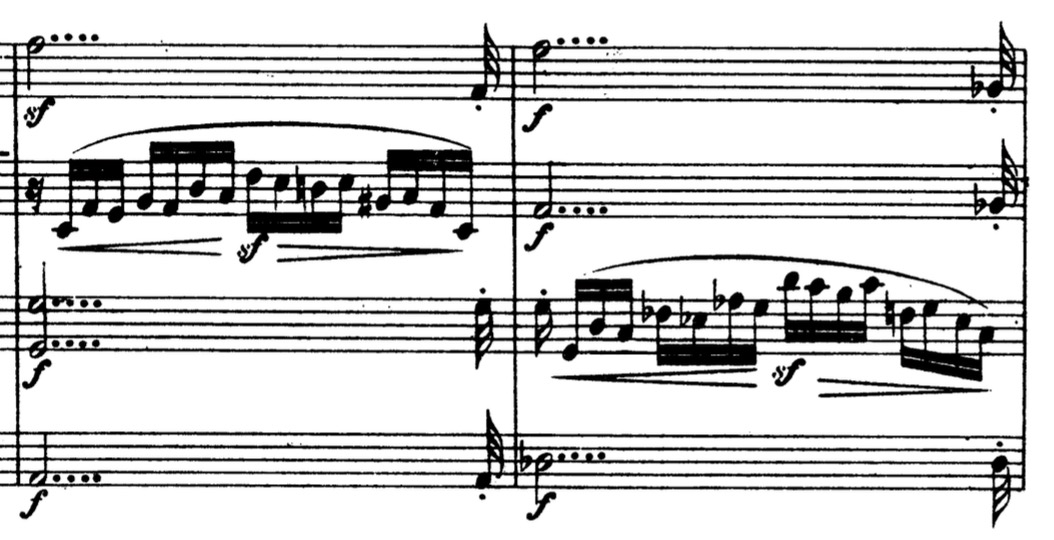Page 1 of 1
A very dotted note (Notational curiosity vol2.)
Posted: 04 Oct 2019, 07:36
by OCTO
Notational curiosity vol2.
Schumann's String Quartet no 1, 3rd movement (
http://ks.imslp.net/files/imglnks/usimg ... 1_scan.pdf )

- scrsht 2019-10-04 at 09.34.25.jpg (150.23 KiB) Viewed 5792 times
I am not sure if I would dare to use so many dots ever.
Re: A very dotted note (Notational curiosity vol2.)
Posted: 04 Oct 2019, 15:22
by RMK
Normally I wouldn't either, but this looks so clear and uncluttered that I might make an exception.
Re: A very dotted note (Notational curiosity vol2.)
Posted: 04 Oct 2019, 16:53
by Yinyue
RMK wrote: ↑04 Oct 2019, 15:22
Normally I wouldn't either, but this looks so clear and uncluttered that I might make an exception.
Agreed. A rare case where it's the cleanest solution.
Thanks for sharing octo!
Re: A very dotted note (Notational curiosity vol2.)
Posted: 04 Oct 2019, 19:05
by John Ruggero
Chopin's Prelude op. 28 no. 3 (1839) has three dots in a very similar situation, if not tempo, and it is also the best notation for the situation:

- Chopin Prelude 3 dots.jpeg (49.45 KiB) Viewed 5752 times
Schumann's Quartets were composed in 1842. Schumann knew Chopin Preludes well since he reviewed them in his magazine. Hmmm....
Re: A very dotted note (Notational curiosity vol2.)
Posted: 04 Oct 2019, 19:59
by OCTO
John Ruggero wrote: ↑04 Oct 2019, 19:05
Chopin's Prelude op. 28 no. 3 (1839) has three dots in a very similar situation, if not tempo, and it is also the best notation for the situation:
Chopin Prelude 3 dots.jpeg
Schumann's Quartets were composed in 1842. Schumann knew Chopin Preludes well since he reviewed them in his magazine. Hmmm....
When I saw your answer briefly I believed that was the piano reduction of Schumann!
Re: A very dotted note (Notational curiosity vol2.)
Posted: 04 Oct 2019, 20:34
by David Ward
There are certainly triple dots in Bruckner in the 9th Symphony, but I think elsewhere too.
I remember a thread on the old Finale forum in which people were complaining about mere double dots on the grounds that ‘most’ sight-readers would get them wrong. Really?
Re: A very dotted note (Notational curiosity vol2.)
Posted: 04 Oct 2019, 22:25
by John Ruggero
OCTO wrote: ↑04 Oct 2019, 19:59
When I saw your answer briefly I believed that was the piano reduction of Schumann!
And I thought: this would be the way I would arrange the Schumann for piano solo!
David Ward wrote: ↑04 Oct 2019, 20:34
There are certainly triple dots in Bruckner in the 9th Symphony, but I think elsewhere too.
I remember a thread on the old Finale forum in which people were complaining about mere double dots on the grounds that ‘most’ sight-readers would get them wrong. Really?
When multi-dotted notes fill up almost an entire measure in this way, it is completely clear; so it is a non-issue in most such cases. And in piano music the other parts clarify. Double dotted notes usually fill up half or quarter measures and are similar.
Then there are the dotted rests... Any one ever seen a quad-dotted rest? Or a yellow-bellied sapsucker?
Re: A very dotted note (Notational curiosity vol2.)
Posted: 05 Oct 2019, 18:15
by HaraldS
The page
Extremes of Conventional Music Notation says:
3. Most augmentation dots {B&I 4.6, 6.7}
Quadruple dots appear in Liszt: Piano Concerto #2 (1839, rev. 1848; Kalmus ed.), Allegro deciso, mm. 327 and 331; Schumann: String Quartet no. 1, Op. 41 no. 1 (1842), III, mm. 16, 17, 33, 34, etc. (contributed by Cuthbert) (in Byrd, 2017a); Verdi: Requiem (1874; Dover ed.), Rex Tremendae, mm. 356 and 358; Franck: Prelude, Chorale, and Fugue (1884; Schirmer ed.), mm. 2 and 4 (in B & M, 1948); Hindemith: Mathis der Maler Symphony (1934; Schott ed.), III, introduction; Bartok: Music for Strings, Percussion, and Celesta (1936; Boosey & Hawkes ed.), III, m. 80; and Einojuhani Rautavaara: Icons, Op. 6 (1955), I ("Jumalanäidin kuolema"), mm. 2-3 (contributed by Arribas). In every case, the dots are on a half note.
Re: A very dotted note (Notational curiosity vol2.)
Posted: 05 Oct 2019, 21:03
by David Ward
I should certainly have remembered the quadruple dots for the chorus in the Verdi Requiem (which also has numerous triple dots in both vocal and instrumental parts).